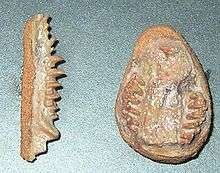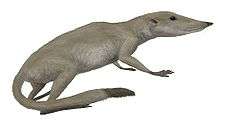Zalambdalestes
| Zalambdalestes Temporal range: Late Cretaceous | |
|---|---|
 | |
| Zalambdalestes lechei skull and lower jaw, Museum of Evolution Warsaw. | |
| Scientific classification | |
| Kingdom: | Animalia |
| Phylum: | Chordata |
| Class: | Mammalia |
| Infraclass: | Eutheria |
| Family: | †Zalambdalestidae |
| Genus: | Zalambdalestes Gregory & Simpson, 1926 |
| Species | |
| |
Zalambdalestes (meaning much-like-lambda robber) was a eutherian mammal, most likely not a placental due to the presence of an epipubic bone,[1][2] living during the Upper Cretaceous in Mongolia.

Zalambdalestes was a shrew-like animal with a long snout, long teeth, a small brain and large eyes. It was about 20 centimetres (7.9 in) long, with a head only 5 centimetres (2 in) long. It had strong front paws and even stronger rear ones, but its claws were not opposable, so it is unlikely to have climbed trees. Its diet was probably composed mainly of insects that it hunted in the forest undergrowth using its sharp, interlocking teeth.[3] Unlike modern placental mammals, Zalambdalestes had an epipubic bone, meaning it was probably restricted reproductively in the same way as modern monotremes and marsupials.[4]
References
- Parker, Steve. Dinosaurs: the complete guide to dinosaurs. Firefly Books Inc, 2003. Pg. 402
- ↑ Dykes, Kevin T. "Mesozoic Mammals; Zalambdalestidae, Lipotyphla?, Cimolestidae and Cretaceous Taeniodonta". Mesozoic Eucynodonts. Archived from the original on March 4, 2006.
- ↑ Kenneth D. Rose, J. David Archibald, The Rise of Placental Mammals: Origins and Relationships of the Major Extant Clades, JHU Press, 22/02/2005
- ↑ Palmer, D., ed. (1999). The Marshall Illustrated Encyclopedia of Dinosaurs and Prehistoric Animals. London: Marshall Editions. p. 201. ISBN 1-84028-152-9.
- ↑ Kenneth D. Rose, J. David Archibald, The Rise of Placental Mammals: Origins and Relationships of the Major Extant Clades, JHU Press, 22/02/2005
Further reading
- Wible, J. R., Novacek, M. J., & Rougier, G. W. (2004). New data on the skull and dentition in the Mongolian Late Cretaceous eutherian mammal Zalambdalestes. Bulletin Of The American Museum Of Natural History 281, 1-144.